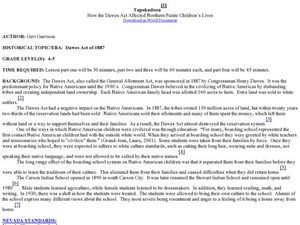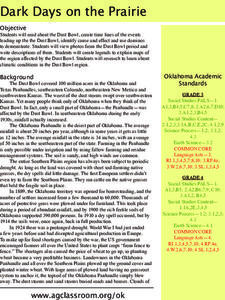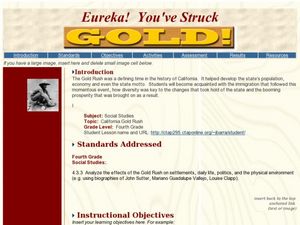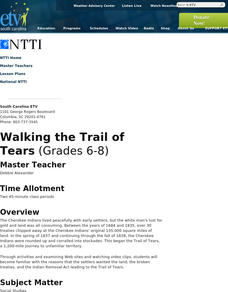Curated OER
Earliest Americans
Students study the Earliest Americans. In this interactive lesson on the Native Americans, students study different tribes over the course of seven lessons. Students culminate their studies with a presentation and assessment.
Curated OER
Native American Project
Learners explore the influences that geography has on a Native American tribe's culture and lifestyle. They examine how the first encounters with Europeans affected that tribe.
Curated OER
Tapokadooa: How the Dawes Act Affected Northern Paiute Children's Lives
Students investigate the Dawes Act and understand its effects on the Paiute Indians. In this Paiute instructional activity, students recognize that many Native Americans lost their land and money after the Dawes Act. Students dissect a...
Channel Islands Film
Natural Resources, and Human Uses of Plants and Animals
As part of their study of the restoration projects on Santa Cruz Island, class members demonstrate their understanding of the connections among plant life, animals, and the actions of humans by crafting a model that reveals these...
Curated OER
Indians of the Plains
Second graders, in groups, explore the Plains Indians and explore how the physical climate of the Plains region affected their lives.
Curated OER
American Indians of the Local Region
Students describe the American Indian nations in their local region long ago and in recent past. They research religious beliefs, customs, and various folklore traditions.
Curated OER
Governance
Students explore government by researching Native American history. In this First Nations culture lesson, students define the Aboriginal action of speaking in a circle as a group. Students discuss their likes and dislikes with the class...
Curated OER
The Latino Religious Experience: People of Faith and Vision
Middle schoolers explain why Columbus said the native peoples he encountered when he reached the New World were "a people who lived in God." They explain if Latinos can still be said to be "a people who live in God." Students explain the...
Curated OER
I Heard the Owl Call My Name
Eleventh graders write a two to three page paper addressing one of the following topics: Analyze the values and beliefs of the two conflicting cultures. Explain which values seem to dominate within the conflict and why. They brainstorm...
Curated OER
Dark Days on the Prairie
Fourth graders research the location and causes of the Dust Bowl in 1935. In support, they interpret photos from that period in Oklahoma history, They also compare/contrast the American Dust Bowl to the dust storms that occurred in...
Curated OER
Legends of the Navajo People
Second graders are read a story in which they begin to examine Native American legends. Using different legends, they discuss how they affected the future people of native peoples. They write a short story on the information they gathered.
Curated OER
Eureka! You've Struck
While incomplete, this lesson could provide ideas for a lesson on the California gold rush. Learners look at a chart to analyze population growth in San Francisco after the discovery of gold, analyze political changes that occurred, and...
Curated OER
Comparing Land Views of Different Cultures
Students research various legends and write a script based on that legend. In this cultural awareness lesson, students read the Native American legend telling of the origin of the earth. Students analyze how the concepts in...
National Endowment for the Humanities
Lesson 1: The First Great Awakening
High schoolers examine the First Great Awakening and how it affected religious belief in colonial America. They read and analyze primary source documents, explore various websites, and write a five-paragraph essay examining the beliefs...
Curated OER
The Martian Chronicles: Concept Analysis
If you're planning on including Ray Bradbury's The Martian Chronicles in your science fiction unit, use a concept analysis guide to frame your instruction. It covers literary elements such as setting, narrative voice, and theme, as...
Curated OER
Treaties
Fifth graders investigate Canadian history by examining the alliances made in the past. In this Canadian treaties lesson, 5th graders identify the Native Americans of Canada, known as the First Nations people or Aboriginals. Students...
Curated OER
Walking the Trail of Tears
Students, through the use of examining video clips and Websites, become familiar with the reasons that the settlers wanted the land, broke treaties, and initiated the Indian Removal Act leading to the Trail of Tears.
Curated OER
Hoosier Artists
Students examine the paintings of various Indiana artists. Using the internet, they relate the landscapes shown to the history of the state and how it affected Native Americans. Using the information they gathered, they write story...
Curated OER
Circle Justice—Lesson 1: The Anger Within
Students examine the emotion of anger through the poem 'A Poison Tree'. In this poetry analysis instructional activity, students identify and decode unfamiliar vocabulary they encounter, engage in groups discussions and complete...
Curated OER
Live from Channel 22
Students explore 1920s America. In this American history lesson, students research primary and secondary sources in order to examine the events and noteworthy people of the time period. Students use their...
Curated OER
Immigration in the United States
Students examine the theory of immigration and how their ancestors became part of this Nation. They determine how immigration affected the United States through research and language activities. They construct a timeline of a time in...
Curated OER
Advanced Critical Reading: Colony Collapse
In this critical reading worksheet, students read a passage about the collapse of bee colonies and then answer questions based on the reading.
Curated OER
Grade Cards
Students examine a school grade card. In this reading lesson, students discuss the school grade card in order to understand how their child is doing in school. Students discuss the symbols and terminology used on the grade cards.
Curated OER
Establishing Borders: U.S. Expansion
Learners interpret historical maps and locate territories annexed by the United States in the 1840. In groups, they research the war with Mexico over Texas from both perspectives and answer on a worksheet about expansion.























